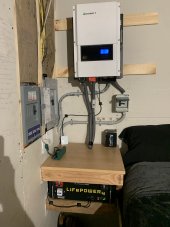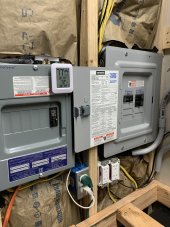Mannfamilywoodworks
Solar Enthusiast
I’ve been pretty confused about two things with my system.
I have a 45’ shipping container.
I’m trying to keep it safe.
It’s powered by a growatt 6k AIO and an EG4 life power battery with 6 -235 watt panels in series.
My output from the growatt is 240v which supplies my AC electrical panel. L1-L2-N-G
from my panel I have a 6 gauge ground wire connected to a small bus bar.
That ground wire runs outside the container through the floor to a 6’ deep grounding rod.
Does all of that makes sense?
Does it sounds sufficient and safe?
Do I need to ground my container and run an additional 6 gauge wire to this grounding rod?
Secondly what is neutral ground bounding.
Why is it used in some instances but not others? Do I need it?
Does it complete the ground fault circuit? I’m not exactly sure. I’ve been told many different things.
Right now I do not have it bonded and it is working fine.
Lastly I have a 30amp -240v -input coming from my generator to a separate panel with separate breakers and outlets for backup.
This panel also has a small bus bar for all the grounds.
Do I connect this bus bar with a 6 gauge ground wire to the other grounds in the other panel?
Or do I put an additional 6’ ground rod in for this additional panel?
I have a 45’ shipping container.
I’m trying to keep it safe.
It’s powered by a growatt 6k AIO and an EG4 life power battery with 6 -235 watt panels in series.
My output from the growatt is 240v which supplies my AC electrical panel. L1-L2-N-G
from my panel I have a 6 gauge ground wire connected to a small bus bar.
That ground wire runs outside the container through the floor to a 6’ deep grounding rod.
Does all of that makes sense?
Does it sounds sufficient and safe?
Do I need to ground my container and run an additional 6 gauge wire to this grounding rod?
Secondly what is neutral ground bounding.
Why is it used in some instances but not others? Do I need it?
Does it complete the ground fault circuit? I’m not exactly sure. I’ve been told many different things.
Right now I do not have it bonded and it is working fine.
Lastly I have a 30amp -240v -input coming from my generator to a separate panel with separate breakers and outlets for backup.
This panel also has a small bus bar for all the grounds.
Do I connect this bus bar with a 6 gauge ground wire to the other grounds in the other panel?
Or do I put an additional 6’ ground rod in for this additional panel?






